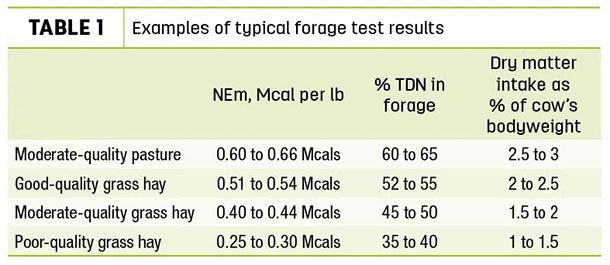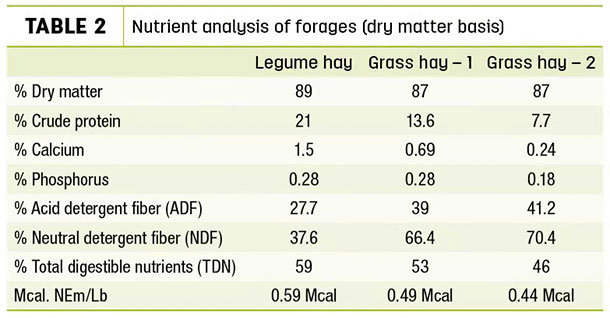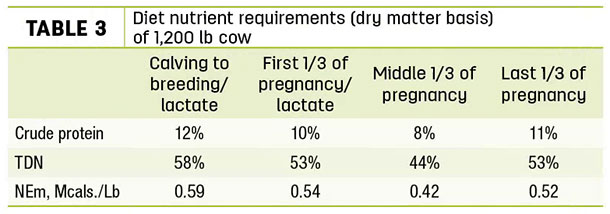How cows utilize forage
The beef cow can digest forage by microbial fermentation, which results in the production of volatile fatty acids (absorbed by the cow for energy) and microbial protein. Due to rumination (cud chewing) and fermentation, forage particles become small enough to eventually pass out of the rumen to the lower gut for further digestion.
Microbes (which contain about 85 percent protein) also pass with these smaller forage particles to the lower gut and serve as an important protein source. Forage needs to contain enough rumen-available protein to allow the microbes to thrive. This becomes challenging when forages mature.
As forages mature, digestible energy, available crude protein and mineral content all decline. Intake will drop as well. In these cases, providing some supplemental protein will stimulate microbial fermentation and forage intake and utilization. Table 1 shows examples of typical forage test results.
Analyze your forage inventory
Analyze your forages to know the type of input you have and where it is best fed. Accurate sampling is a must. Feed consultants and university extension services provide guidelines for accurately sampling pastures or stored forages.
It is critical you know how to interpret results and understand what they mean to your operation. Table 2 shows a typical report comparing different forages.

Here are some important points to remember:
1. Most analyses show “as fed” and “dry matter” nutrient values. Always evaluate feeds based on dry matter nutrient values.
2. Grass hay – 2 only has 7.7 percent crude protein. A forage analysis below 7 percent crude protein will not provide enough rumen-available protein to support microbial growth and adequate fermentation. The legume hay (21 percent crude protein) may serve a role of blending with the other grass hays.
3. Acid detergent fiber is a measure of the cellulose and lignin in a plant. Lignin is not digestible by the rumen microbes. As a plant matures, lignin content increases and acid detergent fiber increases.
4. Neutral detergent fiber is considered a measure of the total fiber (cellulose, hemicellulose, lignin and silica) or bulkiness of a forage and an indicator of how much the cow will eat. The bulkier the forage, the less the cow is likely to eat.
5. Total digestible nutrients estimates digestible energy and has been used for many years. It is important to note all lab energy values are estimates based on calculations.
6. Net energy for maintenance is also a calculation and estimates the energy value of a forage used in maintaining the cow. In our example, this is expressed as mega-calories.
Apply lab results
Table 3 shows the nutrient requirements of a 1,200-pound cow. In an ideal world, you would want to match the calving cycle with pasture quality. Lush growing pastures are often similar to the nutrient content (Table 2) of the legume hay analyzed and would meet requirements of all reproductive phases.

A 50-to-50 ratio combination of the legume hay with grass hay – 1 would meet protein and energy requirements during the first and last third of pregnancy. Some of the legume hay fed with the grass hay – 2 would meet protein and energy needs during the middle third of gestation.
Supplementing – ‘do no harm’
Protein or energy supplementation is sometimes needed. In terms of supplementation, the catchphrase is “do no harm” if you are trying to optimize use of your own forage. What that means is: You need to be careful not to feed so much of one supplement it reduces intake of your forages.
There are two types of supplements: higher-protein/low-starch (corn co-products, soyhulls, wheat midds, soybean meal, sunflower meal) that complement and add to forage digestibility, and higher-starch/low-protein sources that can depress forage utilization.
Generally, try not to feed more than 0.4 percent to 0.6 percent of the cow’s bodyweight per day of a supplemental source of energy or protein. As Table 4 shows, feeding only corn will eventually depress utilization of a lower-quality forage.

In contrast, sources such as corn gluten, corn distillers, soyhulls, etc., contain very digestible fiber and protein which enhance forage intake and utilization. These sources can safely be fed at the higher level (0.6 percent of bodyweight) before they begin competing with your forage.
Another form of “supplementation” needed in optimizing forage utilization is a sound mineral program. This is a year-round necessity. As pastures mature, phosphorus content tends to decrease, as do important trace minerals like zinc and copper.
Rumen microbes have a high requirement for phosphorus. (They contain 2 to 6 percent phosphorus.) Often, providing some additional rumen-available phosphorus stimulates microbial fermentation and pasture utilization. Optimizing forage or pasture utilization translates into improved milk production, better suckling-calf gains, better cow condition and better reproduction.
Vitamin A is incredibly important for reproduction and health. It doesn’t take long before pastures begin rapidly losing their beta-carotene or vitamin A value as they mature.
Effective supplementation requires an understanding of the nutritional value of your forages and how the forage impacts your cows. Do not underestimate the importance of analyzing your forage and, more importantly, appropriately applying the results of that analysis to your operation. ![]()

-
Randy Dew
- Cargill Animal Nutrition
- Email Randy Dew








